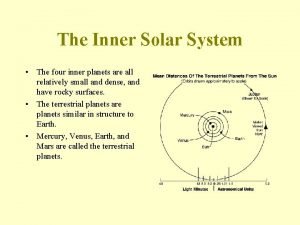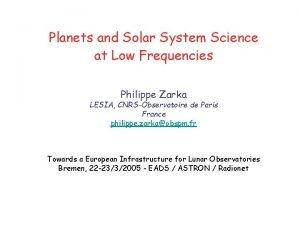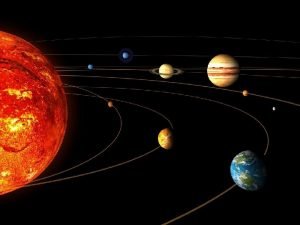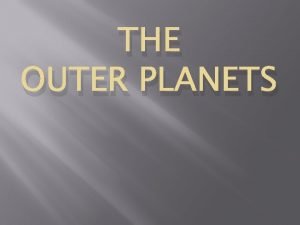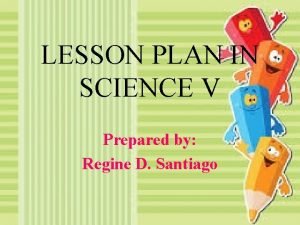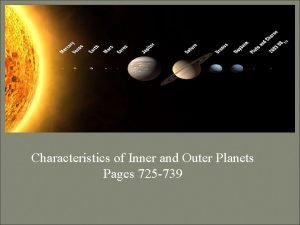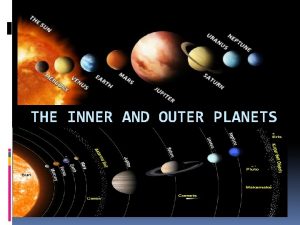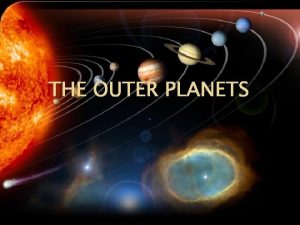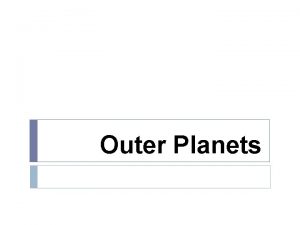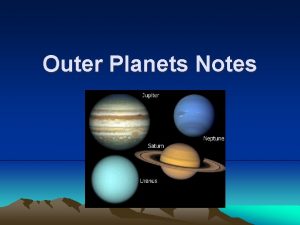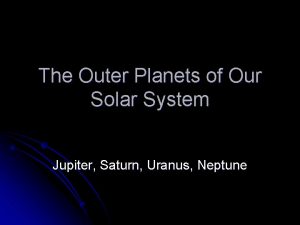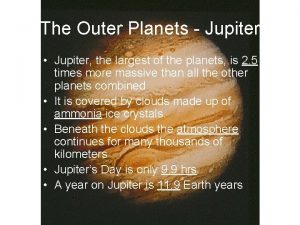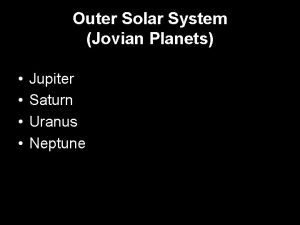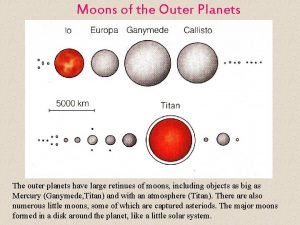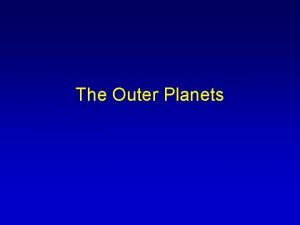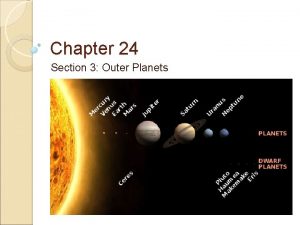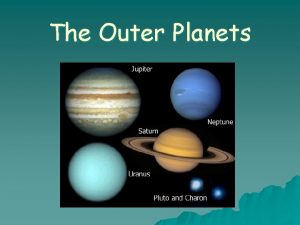THE OUTER PLANETS OF OUR SOLAR SYSTEM Jupiter














- Slides: 14

THE OUTER PLANETS OF OUR SOLAR SYSTEM

Jupiter Distance from Sun: 43. 3 light-minutes Period of rotation: 9 hours and 54 minutes Period of revolution: 11 years and 313 days Diameter: 142, 984 km Density: 1. 33 g/cm Temperature: -110°C Gravity: 236% of Earth's

Jupiter facts Jupiter is the biggest of the gas planets Jupiter is the largest planet in our solar system Jupiter’s giant red spot is a storm system that is 400 years old and is about 3 times the size of the Earth

Saturn Distance from Sun: 1. 3 light-hours Period of rotation: 10 hours and 42 minutes Period of revolution: 29 years and 155 days Diameter: 120, 536 km Density: 0. 69 g/cm Temperature: -140°C Gravity: 92% of Earth's

Saturn facts Saturn is the second largest Saturn is 95 times more massive than Earth Saturn has the biggest rings of the gas giants with a total diameter of 272, 000 km

Uranus • • Distance from Sun: 2. 7 light-hours Period of rotation: 17 hours and 12 minutes(retrograde rotation) Period of revolution: 83 years and 273 days Diameter: 51, 118 km Density: 1. 27 g/cm Temperature: -195°C Gravity: 89% of Earth's

Uranus was discovered in 1781 by English amateur astronomer William Herschel Uranus is tilted 90° on is axis, and it almost lies in its plane of orbit

Neptune Distance from Sun: 4. 2 light-hours Period of rotation: 16 hours and 6 minutes Period of revolution: 163 years and 263 days Diameter: 49, 528 km Density: 1. 64 g/cm Temperature: -200°C Gravity: 112% of Earth's

Neptune Is the smallest of all of the gas giant planets Astrometry believe that the gravity of Neptune pulled Uranus off of it’s predicted path Neptune has a set of very narrow rings around it

Pluto Distance for sun: 5. 4 light-hours Period of rotation: 6 days 10 hours Period of revolution: 248 years and 4 days Diameter: 2, 390 km Density: 1. 75 g/cm Surface temperature Surface gravity: 6% of Earth’s


Pluto facts Pluto was discovered in 1930 Pluto is the smallest planet in our Solar System Pluto was original called the mystery planet Pluto’s moon Charon is about half the size of Pluto

Terrestrial and Jovian Planets Why?

Observational Differences between Planets & Stars STARS PLANETS The planets move relative to stars on celestial sphere The nearer and larger planets appear as disks in telescope The brighter planets do not "twinkle“ The planets are always near the imaginary yearly path of the Sun on the celestial sphere (the ecliptic) The relative positions of the stars are fixed on celestial sphere The stars appear as "points" of light, even through the telescope The stars appear to "twinkle" Stars can be anywhere on the celestial sphere
 Outer planets
Outer planets What separates the inner planets and outer planets
What separates the inner planets and outer planets What is each planet made of
What is each planet made of Inner terrestrial planets
Inner terrestrial planets My very excited mother planets
My very excited mother planets What are the four inner planets
What are the four inner planets Why do jovian planets have rings
Why do jovian planets have rings 4 inner planets
4 inner planets Solar system planets
Solar system planets Easy way to remember planets
Easy way to remember planets Saturn compared to earth
Saturn compared to earth Jupiter is noticeably oblate because:
Jupiter is noticeably oblate because: Inner outer planets venn diagram
Inner outer planets venn diagram Characteristics of the planets
Characteristics of the planets What separates the inner and outer planets
What separates the inner and outer planets





